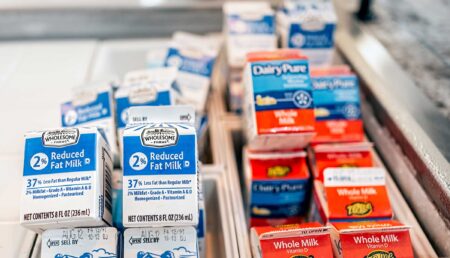By Ryan Hanrahan
USA Today’s Marc Ramirez reported that “Nebraska has confirmed its first case of bird flu in a dairy cattle herd as a lingering 18-month outbreak continues to afflict livestock nationwide, the U.S. Department of Agriculture announced on Sept. 15.”
“The state’s department of agriculture, aided by the USDA’s Animal and Plant Health Inspection Service, said in a press release that it had confirmed the case of highly pathogenic avian influenza in a central Nebraska herd and that the herd had been quarantined,” Ramirez reported. “Though decelerating, cases of H5N1 bird flu have now been confirmed in more than 1,000 herds across 17 U.S. states since the virus was initially found in dairy cows in March 2024, according to the USDA, including cases this year in Texas, Arizona, Idaho, Nevada, Michigan and California.”
Courtesy of the USDA APHIS
“The National Veterinary Services Laboratories said the strain resembles one found in California, the department said, adding that with care, dairy cattle typically recover with little to no associated mortality,” Ramirez reported.
“Scott Hensley, a professor of microbiology at the (University of Pennsylvania), told USA TODAY the announcement wasn’t unexpected given the virus’s ongoing circulation among cattle,” Ramirez reported. “‘It will be important to determine if the Nebraska herd represents a new bird-to-cow infection, or if the virus was brought into the state by an already infected cow,’ he said.”
Minnesota Detects Case in Commercial Turkey Flock
MPR News’ Kirsti Marohn reported that “animal health officials have detected bird flu in a turkey flock in Redwood County, the first new confirmed case of highly pathogenic avian influenza in Minnesota poultry since April.”
“The state Board of Animal Health said the flock of about 20,000 turkey toms experienced an unusually high number of deaths. Lab tests confirmed they had influenza A and the H5 strain of bird flu,” Marohn reported. “The U.S. Department of Agriculture’s national lab in Ames, Iowa, confirmed the results.”
“The new case is not entirely surprising as wild waterfowl begin their fall migration, said Dr. Shauna Voss, assistant director of the Board of Animal Health,” Marohn reported. “‘Vigilance and robust biosecurity remain the best methods for flock owners to protect poultry from avian influenza,’ Voss said.”
Poultry Producers Continue Push for Vaccine
CBS News’ John Lauritsen reported that “a year ago (Minnesota farmer Jake) Vlaminck says a majority of Minnesota turkey farmers weren’t interested in an avian influenza vaccine for their birds. Now, he says, that mindset has changed. As president of Minnesota Turkey Growers Association, he and 15 other farmers recently traveled to Washington to meet with lawmakers and to push for a vaccine.”
“‘It’s going to be a while. The first step is we have to figure out what that strategy would be, what would it look like. That’s something that will have to come from the USDA,’ said Vlaminck,” according to Lauritsen’s reporting. “He believes a vaccine could be available in the next year or two. Until then, he’ll rely on lasers and biosecurity to protect his birds.”
“‘Turkey is a big economic engine for Minnesota. So, it’s not just the farmer on the farm it’s also the people who process it. It’s the people who make the feed, grow the crops, all the people in-between who fix the trucks and make sure everything stays running,’ said Vlaminck,” according to Lauritsen’s reporting. “Minnesota is the nation’s top turkey producer, and the USDA said it is safe to eat. In recent years there have also been cases of avian influenza in dairy cows, but those cases have not been fatal, and milk is safe to consume.
Bird Flu Persists As Cattle Infected in Nebraska was originally published by Farmdoc.


:max_bytes(150000):strip_icc()/29914890324_aa73e98b2d_o-6f344ec3cf7c42588a397ea481241aa3.jpg)
:max_bytes(150000):strip_icc()/JohnDeere_Autonomy_r4k079314_rrd-a616d090c9c146f585345a32cf23fd74.jpg)
:max_bytes(150000):strip_icc()/iowa-river-iowa-falls--2048x1536-e28890b87e014dadaada5d8dd012b516.jpg)


:max_bytes(150000):strip_icc()/100858097_dairy_cow-e656e7ed1734481e894b0197ef9fdb67.jpg)
:max_bytes(150000):strip_icc()/47075387454_577e826006_o-af71ed3c08d8463c8580a9b189fa2e58.jpg)
:max_bytes(150000):strip_icc()/Markets-9-Corn-down-soybeans-down-8-3d682c335a5f4fd4b6f40bdf3c85708f.jpeg)
